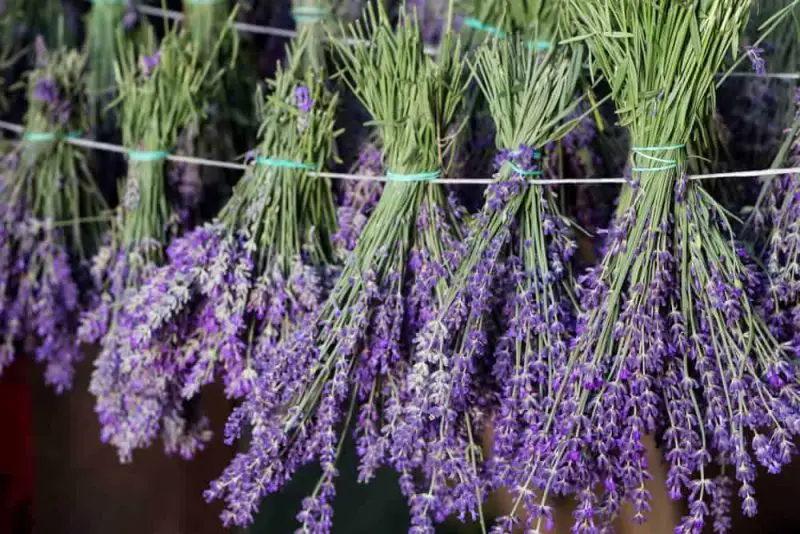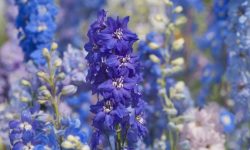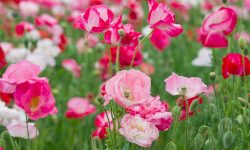There’s something magical about lavender—the way its slender stems dance in the breeze, the soothing scent that lingers long after summer fades, and the soft purple hues that calm both eyes and spirit. Whether tucked into sachets, brewed into tea, or displayed in rustic bundles, dried lavender carries the memory of warm sun and fragrant fields into cooler seasons.
Learning how to dry lavender the right way is more than a simple preservation technique; it’s an act of care and connection to nature. When done correctly, drying lavender preserves its color, protects its delicate scent, and extends its usefulness for everything from home décor to culinary recipes. This guide will walk you through each step with clarity and detail, helping you achieve beautiful, fragrant results every time.
Understanding Lavender and Its Drying Potential

Why Lavender Is Ideal for Drying
Lavender is one of the few flowers that retains both its scent and structure remarkably well when dried. Its essential oils are concentrated in tiny buds along the flower spike, and when harvested at the right moment, these oils remain potent even after the drying process. The structure of the flower head, along with its natural resistance to decay, makes lavender a perfect candidate for long-lasting preservation.
The Purpose of Drying Lavender
Drying lavender allows you to enjoy its benefits long after the growing season ends. Whether you want to craft aromatic sachets, make soothing teas, or simply hang decorative bunches around your home, dried lavender offers a way to hold onto its charm year-round. Proper drying enhances both fragrance and color, ensuring that your efforts yield not just longevity, but beauty and usefulness as well.
Choosing the Right Time to Harvest Lavender for Drying
Understanding Flower Maturity
The key to drying lavender successfully begins with harvesting at the correct stage of bloom. Lavender should be cut when the flower buds are fully developed but have not yet fully opened. At this stage, the essential oils are at their peak concentration, and the flowers are less likely to shatter or drop petals during the drying process. If harvested too early, the buds may not develop their full scent. If harvested too late, you risk losing both color vibrancy and fragrance.
Seasonal Timing and Daily Conditions
In most climates, the best time to harvest lavender is in early to mid-summer, typically from late June to early July, depending on your zone and variety. It’s ideal to harvest in the morning after the dew has evaporated but before the sun becomes too intense. This is when the oils are most concentrated in the buds rather than dissipating into the air under heat. Choosing a dry, sunny day for harvest ensures that moisture doesn’t linger on the stems and promotes faster, cleaner drying.
Recognizing Visual and Tactile Cues
Look for lavender stems where the bottom third of the flower spike is just beginning to open while the rest remains in tight bud. These spikes will provide the best scent and strongest color when dried. The stems should feel firm and straight—avoid any that are bending or showing signs of wilt, as these may not dry evenly and can develop mold. If you gently pinch a bud and it gives off a rich, herbal fragrance, it’s ready.
Preparing Lavender for the Drying Process
Before you begin drying your freshly harvested lavender, proper preparation is essential to ensure the best results in fragrance, color, and preservation. Start by gently shaking each stem to remove any insects or garden debris. Use clean, sharp garden shears to trim off any yellowing leaves or damaged sections near the base of the stem, as these can introduce moisture or mold during the drying period. Avoid washing the lavender unless absolutely necessary, as excess moisture can delay drying and reduce essential oil content.
Next, group the lavender into small, uniform bunches—typically 10 to 15 stems each—to allow for good air circulation. Tie the bunches tightly at the base with string, twine, or rubber bands, keeping in mind that the stems will shrink slightly as they dry. Make sure each bundle is balanced in size and length for even hanging. Preparing the lavender carefully at this stage will not only protect the integrity of the plant but also preserve its aromatic qualities for months to come.
Best Methods for Drying Lavender Indoors and Outdoors
Once your lavender bundles are prepared, the drying location becomes critical. Choose a space that is dark, dry, and well-ventilated to preserve the plant’s essential oils and prevent discoloration from direct sunlight. Ideal drying spots include attics, closets, shaded porches, or sheds with open windows. The temperature should remain consistent—between 60°F and 70°F (15°C to 21°C)—and humidity should stay below 50% to discourage mold or mildew. If your indoor air tends to be moist, consider using a fan to improve air movement around the bundles or a dehumidifier for better control.
Hang each bundle upside down from hooks, nails, or a drying rack, ensuring that no two bunches touch each other. This prevents moisture buildup and allows even air circulation. Depending on the environment, lavender typically takes between 1 to 2 weeks to fully dry. You’ll know it’s ready when the stems feel brittle to the touch and the buds crumble easily between your fingers. At this stage, your lavender is ready for long-term storage or immediate use in sachets, potpourri, floral arrangements, or homemade products like infused oils or bath soaks.
Store Dried Lavender for Long-Lasting Fragrance and Color
Once your lavender has dried thoroughly, proper storage is key to preserving its delicate fragrance, vibrant color, and therapeutic properties. Begin by gently stripping the buds from the stems, either by hand or by lightly shaking the bundles over a clean cloth or tray. Handle the buds carefully to avoid bruising them, as this can release the essential oils prematurely. For best results, store the dried lavender in airtight containers—preferably glass jars, metal tins, or ceramic crocks with tight lids. These materials help block out moisture and air exposure, both of which can degrade scent and potency over time.
Keep your containers in a cool, dry, and dark place such as a pantry, cabinet, or drawer away from direct sunlight, which can cause the lavender to fade and lose its aromatic intensity. If you prefer to store lavender on the stem for use in bouquets or decorations, wrap the bundles in breathable fabric like muslin or brown kraft paper, and place them in a flat, well-ventilated box. Avoid using plastic bags for long-term storage, as they tend to trap humidity and may cause mold or mildew if conditions aren’t ideal. With the right storage techniques, your dried lavender can remain fragrant and beautiful for over 12 months—perfect for everything from homemade sachets and bath soaks to culinary infusions and potpourri blends.
Creating Lavender Sachets and Decor from Dried Blooms
Once your lavender is properly dried and stored, it opens the door to a world of charming, fragrant creations that go far beyond the garden. One of the most delightful ways to use dried lavender is by making homemade sachets. These small fabric pouches, often tucked into drawers or closets, offer a gentle and lasting scent that keeps linens fresh and spaces naturally aromatic. You can use muslin, cotton, or lace fabric, and simply fill each pouch with a handful of dried buds before tying them closed with twine or ribbon. If you want to add a rustic touch, try sewing them by hand using lavender-themed prints.
In addition to sachets, dried lavender can elevate your home decor. Bundle stalks into decorative bouquets and place them in vases around your living room or kitchen for a country-inspired look. Lavender wreaths are another popular craft, often used to add charm to entryways or indoor walls. These can be made by wiring dried sprigs onto a wreath form in overlapping layers, creating a full, elegant display that retains its fragrance for months. For a minimalist aesthetic, a few stems tied with natural ribbon and hung upside down on a hook can transform any space with subtle beauty and scent.
Dried lavender is also a favorite for making potpourri blends. You can combine it with other dried flowers like rose petals or chamomile, and enhance the aroma with a few drops of essential oils. Whether you prefer a calming blend for your bedroom or a refreshing scent for shared spaces, lavender-based potpourri is a natural and personal touch.
These creative uses not only add beauty and fragrance to your home but also help you make the most of your lavender harvest year-round.
Understanding Lavender Harvest Timing by Variety
Not all lavender varieties bloom at the same time or respond equally to drying, so understanding their unique characteristics is essential for successful preservation. English lavender (Lavandula angustifolia), known for its rich aroma and fine stems, typically blooms from late spring to early summer. It’s ideal for culinary use and dries exceptionally well if harvested just before full bloom. French lavender (Lavandula dentata) and Spanish lavender (Lavandula stoechas), which are more ornamental and bloom earlier, have softer petals and should be harvested as soon as the flowers open to prevent loss of shape. Lavandin (Lavandula × intermedia), a hybrid, blooms mid to late summer and offers long, thick stems and high oil content, making it perfect for drying in bunches or for oil extraction. By timing the harvest according to variety, you can preserve both scent and visual appeal more effectively.
Common Mistakes When Drying Lavender
Drying lavender requires attention to technical details that, if overlooked, can reduce fragrance, color, and longevity. One key mistake is harvesting too late—when flowers are fully open, oils have already peaked, and petals shed easily. For best results, cut stems when just a few buds at the base begin to open.
Improper bundling is another issue. Tight bunches can trap moisture and encourage mold, while loose ones dry unevenly. Use small bundles secured with rubber bands, which contract as the stems shrink, maintaining airflow without squeezing too tightly.
Drying location also matters. High humidity or inconsistent temperatures—like in garages or basements—slow drying and promote rot. Ideal conditions include a dark, dry space with good airflow and temperatures between 60–70°F (15–21°C). Air circulation, such as from a fan, speeds the process safely.
Exposing lavender to sunlight is a common but harmful practice. UV light fades color and weakens essential oils. Always dry in a dark or shaded, well-ventilated area to retain vibrancy and scent.
Finally, avoid high heat methods like ovens or dehydrators, which degrade essential oils. Air-drying over 7–14 days is the best approach. With the right techniques, your lavender will preserve its fragrance, structure, and soothing color beautifully.
Best Practices for Preserving Lavender Color
Preserving lavender’s iconic purple hue during the drying process requires careful attention to environmental conditions. Always dry lavender in a cool, dark, and well-ventilated area to protect its color pigments from light degradation. Sunlight, especially direct UV exposure, is the primary cause of color loss, so avoid hanging bunches near windows or in bright rooms. Use rubber bands to secure small bundles of lavender and hang them upside down to encourage straight stems and even drying. Maintain moderate humidity—too much moisture in the air slows drying and increases the risk of discoloration. Once dried, store your lavender in opaque, airtight containers or brown paper bags to keep light and moisture out. These small precautions can make a big difference in preserving the vivid color of your dried blooms for months.
Safety Tips When Using Dried Lavender
While dried lavender is safe for many uses, there are a few important safety considerations to keep in mind. First, if you plan to use dried lavender in food or tea, make sure the flowers are labeled as culinary-grade and haven’t been treated with pesticides or synthetic fertilizers. Always wash tools and drying surfaces beforehand to prevent contamination. When crafting with dried lavender, such as in sachets or potpourri, be mindful of allergies—some individuals may be sensitive to its strong scent. If you have pets, particularly cats, avoid placing dried lavender within reach, as ingestion in large quantities could cause mild stomach upset. For households with young children, ensure dried bundles are out of reach and not mistaken for toys or edible herbs. Practicing these safety tips ensures that your enjoyment of lavender remains healthy and worry-free.
Creative Culinary Uses for Dried Lavender
Dried lavender can lend a delicate floral note to a wide range of culinary creations when used sparingly and thoughtfully. One of the most popular uses is in herbal teas, often blended with chamomile or mint for a calming effect. In baking, a pinch of ground lavender buds adds a sophisticated twist to cookies, shortbread, and scones. You can also infuse dried lavender in sugar or honey to elevate beverages and desserts with a subtle fragrance. Lavender pairs surprisingly well with citrus zest and vanilla, making it an ideal ingredient in syrups, lemonades, and even cocktails. For savory dishes, it’s best used as part of the classic Herbes de Provence blend to flavor roasted vegetables, lamb, or poultry. Always start with small quantities to avoid overpowering your dish—lavender’s flavor is potent, and a little goes a long way.
FAQ: Frequently Asked Questions About Drying Lavender
When is the best time to harvest lavender for drying?
The best time to harvest lavender is in the morning after the dew has evaporated but before the heat of the day. Look for stems where the lowest buds have just begun to open, but the rest remain closed. This is when the essential oil content is highest, ensuring the most fragrance and color after drying.
How long does it take to dry lavender naturally?
Lavender usually takes between 7 to 14 days to dry completely, depending on humidity and air circulation. To speed the process while preserving quality, hang small bundles upside down in a dark, dry, well-ventilated space. Avoid rushing the process with artificial heat, as this can degrade the oils and fade the blooms.
Can I dry lavender in a dehydrator or oven?
Technically, yes—but it’s not recommended. High heat from ovens or dehydrators can cause the delicate essential oils to evaporate too quickly, leaving the lavender less fragrant and brittle. Air drying is a gentler, more effective method that protects both scent and structure.
Why is my dried lavender turning brown or losing its scent?
Browning or fading typically results from drying in direct sunlight or in areas with poor air circulation. Mold or mildew can also occur if the bundles are too thick or if drying takes place in a damp environment. To retain color and aroma, always dry in a shaded, airy place and keep bundles small and spaced apart.
What’s the best way to store dried lavender long-term?
Once fully dry, store lavender in airtight containers like glass jars or sealed paper bags, kept in a cool, dark cabinet. Avoid plastic bags, which can trap residual moisture. Properly stored, dried lavender can retain its scent and beauty for up to a year or more.
Conclusion
Drying lavender at home is more than just a garden task—it’s a way to preserve the beauty, aroma, and calm that this cherished herb brings into your life. By choosing the right time to harvest, using gentle drying techniques, and storing your lavender properly, you unlock its full potential for months to come. Whether you plan to craft with it, use it in teas or sachets, or simply enjoy its fragrance around the house, well-dried lavender offers a lasting connection to the garden. With a little care and attention, each bundle becomes a fragrant reminder of nature’s grace and resilience.






